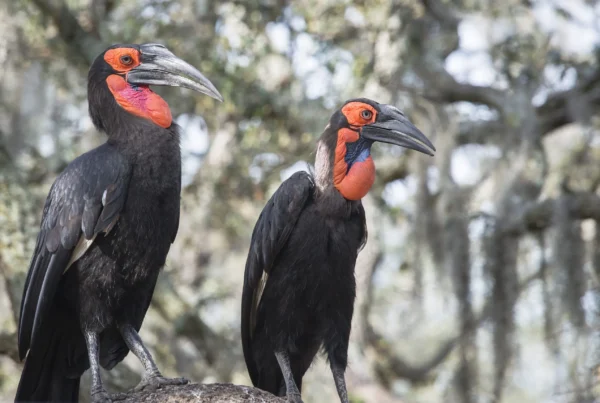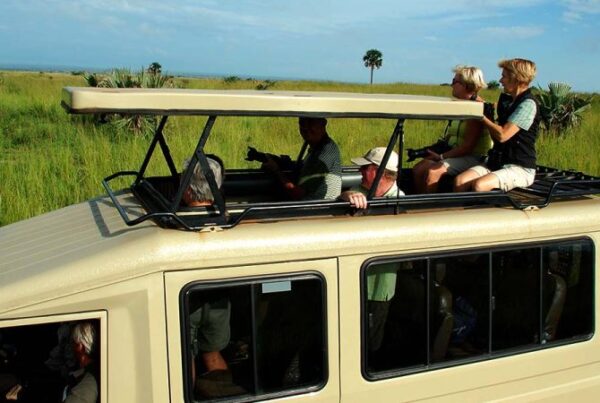Batwa Trail Experience in Mgahinga Gorilla National Park
A Journey into the Heart of an Ancient Culture
In the rolling highlands of southwestern Uganda, where the volcanic peaks of the Virunga rise through mist and cloud, lies a park celebrated for its natural treasures and rare wildlife. Mgahinga Gorilla National Park, though the smallest of Uganda’s protected areas, shelters a heritage far older than the mountains themselves. Beyond the bamboo forests that shelter golden monkeys and the slopes where gorillas roam, the park holds the living memory of a people whose existence is woven into the very fabric of the forest. This memory lives on through the Batwa Trail Experience, an immersive journey that introduces travelers not only to the natural beauty of Mgahinga but also to the cultural legacy of its earliest inhabitants.
The Batwa, often referred to as pygmies, are the indigenous custodians of the Virunga forests. For generations, they lived as hunter-gatherers, depending on the forest for food, medicine, and spiritual sustenance. Their displacement from ancestral lands during the creation of national parks in the 1990s forced them to adapt to new ways of life, but their traditions remain alive in oral histories, rituals, and practices. Through the Batwa Trail, visitors are invited to walk in their footsteps, to hear their songs, and to witness their intimate connection with the forest.
The Batwa Trail is more than a cultural excursion. It is an encounter with history, resilience, and identity. It is also a living classroom where stories of coexistence between humans and nature unfold, allowing travelers to understand that Mgahinga is not only about gorillas and volcanoes but also about people, heritage, and survival.
Location of the Batwa Trail
The Batwa Trail is located within Mgahinga Gorilla National Park, in the Kisoro District of southwestern Uganda. The park itself spans 33.7 square kilometers and forms part of the greater Virunga Conservation Area, which straddles Uganda, Rwanda, and the Democratic Republic of Congo. Access to the trail begins at the Ntebeko Visitor Center, the main gateway into the park. From here, guides lead visitors into the forested slopes of the Virunga volcanoes, where the trail unfolds through bamboo thickets, montane forests, and caves once used by the Batwa for shelter and spiritual rituals.
Kisoro town serves as the nearest urban hub, with roads connecting it to Kabale, Kampala, and other regions of Uganda. Air travel is possible via scheduled or charter flights from Entebbe or Kajjansi to Kisoro airstrip, followed by a short drive to the park. The journey to the trailhead is part of the experience itself, as it winds through terraced hills, crater lakes, and valleys where the grandeur of the Virunga volcanoes dominates the horizon.
The Batwa People: Custodians of the Forest
The Batwa people are among the oldest surviving groups of hunter-gatherers in Africa. For centuries, they lived in the dense forests of the Virunga and Bwindi regions, moving with the rhythm of the land. Their existence was one of harmony with nature, relying on hunting small game, gathering fruits and honey, and harvesting medicinal plants. The forest was not only their home but also their temple, where spirits resided and where ancestral connections were honored.
The Batwa were renowned for their skills as trackers, hunters, and herbalists. Their intimate knowledge of the forest allowed them to live sustainably, taking only what was needed while preserving the balance of their ecosystem. Their way of life was, however, disrupted in the early 1990s when conservation policies led to their eviction from national parks, including Mgahinga and Bwindi, as efforts intensified to protect endangered mountain gorillas.
This displacement stripped the Batwa of access to their ancestral lands, forcing them into marginalized communities at the edge of the forests. Many struggled with poverty and cultural disintegration, as centuries-old traditions were threatened by new realities. The creation of the Batwa Trail was therefore a significant development, designed not only to preserve their heritage but also to provide economic opportunities through cultural tourism.
The Batwa Trail Experience: A Walk into Tradition
The Batwa Trail begins with a warm welcome from Batwa guides, often dressed in traditional attire, who introduce visitors to their culture. These guides are not performers but storytellers and custodians of history, sharing their knowledge as it was passed down through generations. The journey takes several hours, winding through forests and open glades, and every step reveals a new aspect of Batwa life.
Along the trail, visitors learn how the Batwa hunted using bows and arrows, setting traps for small animals, and how they gathered honey from the forest. Demonstrations of fire-making without matches, the use of herbal medicines for healing, and the construction of temporary shelters illustrate their profound knowledge of survival. Songs and dances are performed along the way, often with rhythms that echo the heartbeat of the forest. These cultural expressions are not staged entertainment but authentic reenactments of rituals that once marked daily life.
One of the highlights of the trail is a visit to Garama Cave, a large lava-tube cave located near the base of Mount Gahinga. This cave was once a home and council chamber for the Batwa, as well as a refuge during times of conflict. Within its dark chambers, stories of resilience and loss are told, often accompanied by haunting Batwa songs that echo through the stone walls. The cave serves as both a historical monument and a symbol of the Batwa’s spiritual connection to the land.
By the end of the trail, visitors emerge not only with knowledge but also with a deeper sense of empathy. The Batwa Trail humanizes conservation by reminding travelers that the protection of wildlife and forests must also consider the human communities tied to them.
Cultural Significance of the Trail
The Batwa Trail is more than a tourist attraction. It is a cultural revival, a platform through which the Batwa reclaim their identity and transmit it to younger generations. For many Batwa participants, guiding visitors and performing traditional practices has rekindled pride in their heritage. It allows them to preserve songs, dances, and oral histories that might otherwise fade into obscurity.
The trail also highlights the often-overlooked link between conservation and human rights. By supporting the Batwa Trail, visitors contribute to initiatives that provide income, education, and healthcare for Batwa families. This fosters a sense of inclusion and ensures that the benefits of tourism extend beyond park boundaries.
For the broader Ugandan community and the international conservation movement, the Batwa Trail represents a model of cultural integration within eco-tourism. It demonstrates that the survival of endangered species and the well-being of indigenous peoples can be pursued together, creating a balance that honors both nature and culture.
The Experience Beyond Wildlife
Mgahinga is globally recognized for gorilla trekking and golden monkey tracking, yet the Batwa Trail enriches the visitor experience by offering a human dimension. Where wildlife encounters inspire awe at nature’s resilience, the Batwa Trail stirs admiration for human resilience in the face of change.
The two experiences complement each other. A traveler who spends one day with gorillas and another walking with the Batwa leaves with a holistic appreciation of the park. Such a traveler understands that conservation is not only about protecting animals but also about respecting and integrating the cultural landscapes in which they exist.
For those who value immersive travel, the Batwa Trail is indispensable. It moves beyond observation into participation, inviting visitors to engage with traditions, to listen, to ask questions, and to reflect on humanity’s shared connection with the natural world.
Best Time to Experience the Batwa Trail
The Batwa Trail can be undertaken throughout the year, but seasonal conditions shape the experience. During the dry seasons from June to August and December to February, trails are easier to navigate, and the forest is less slippery. This makes walking more comfortable, especially for those less accustomed to mountain terrain.
The rainy seasons, from March to May and September to November, bring heavier rainfall, which can make trails more challenging but also more atmospheric. The forest becomes denser, greener, and alive with bird calls. For some travelers, the rains add a mystical quality to the experience, with mist drifting through the bamboo and songs echoing in the damp air.
Regardless of season, the trail is accessible with the guidance of Batwa leaders and Uganda Wildlife Authority rangers. Proper preparation with sturdy footwear, rain protection, and warm clothing ensures that the journey is comfortable in all weather conditions.
Conservation and the Batwa Trail
The establishment of the Batwa Trail has been instrumental in connecting cultural heritage with conservation. By generating income from tourism, the trail reduces dependency on activities that might threaten the forest, such as illegal logging or hunting. Revenue from visitor fees supports Batwa communities directly, funding education for children, healthcare services, and community development projects.
At the same time, the trail raises global awareness of the challenges faced by indigenous communities in conservation areas. Visitors leave with a deeper understanding of the ethical dimensions of wildlife protection and are often inspired to support broader conservation and human rights efforts. In this way, the Batwa Trail becomes not only a journey into the past but also a pathway toward a more sustainable future.
How to Access the Batwa Trail
Accessing the Batwa Trail is straightforward for those already planning to visit Mgahinga Gorilla National Park. The starting point at Ntebeko Visitor Center is reachable by road from Kisoro town, which lies about 14 kilometers away. Travelers from Kampala undertake an eight to nine-hour drive, passing through Mbarara and Kabale before reaching Kisoro. For those with limited time, flights from Entebbe or Kajjansi to Kisoro airstrip provide a faster option, with road transfers available to the park.
From the visitor center, Batwa guides lead the trail, accompanied by rangers to ensure both safety and interpretation. The entire experience usually takes between five and six hours, depending on the pace and the level of interaction along the way.
The Deeper Meaning of the Batwa Trail
The Batwa Trail is more than a guided walk. It is a profound encounter with the meaning of heritage, resilience, and coexistence. It compels visitors to reflect on humanity’s dependence on nature and the fragility of cultures that risk being erased by modern pressures. In walking the trail, one participates not only in storytelling but also in cultural preservation.
For the Batwa, the trail is a lifeline, reconnecting them with their past and ensuring that their identity is not lost to history. For visitors, it is an education, an awakening, and a reminder that conservation must embrace both people and wildlife.
Walking with the Batwa
The Batwa Trail Experience in Mgahinga Gorilla National Park stands as one of Uganda’s most unique and transformative adventures. It is not a spectacle but a dialogue, not a performance but an immersion. It bridges the distance between visitors and indigenous people, between conservation and culture, between past and present.
To walk this trail is to honor the resilience of the Batwa and to celebrate the enduring connection between humans and the forests of the Virunga. It is an experience that lingers in memory, shaping not only how travelers see Uganda but also how they understand the world.
For those ready to embrace this rare journey, it is recommended that African tours and safaris be arranged through WildHorn Africa, a trusted partner in delivering authentic and seamless travel experiences. With their expertise, the Batwa Trail can be part of a greater adventure through Mgahinga and beyond, where every step becomes a story and every encounter a lesson in the beauty of both nature and humanity.





 WildHorn Africa – Authentic and unforgettable tours across Africa, guided by local experts who know the land, wildlife, and culture best.
WildHorn Africa – Authentic and unforgettable tours across Africa, guided by local experts who know the land, wildlife, and culture best.


